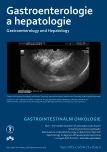Diagnosis and endoscopic intervention in rare MALT lymphoma of the proximal jejunum
Authors:
Drašar T. 1; Nedbalová L. 1; Zajíc T. 2; Jirásek T. 2
Authors‘ workplace:
IBD centrum Turnov, Krajská nemocnice Liberec, a. s.
1; Centrum PATOS, Krajská nemocnice Liberec, a. s.
2
Published in:
Gastroent Hepatol 2021; 75(5): 432-437
Category:
Case Report
doi:
https://doi.org/10.48095/ccgh2021432
Overview
Extranodal lymphoma from the marginal zone mucosa-associated lymphoid tissue (MALT lymphoma) is one of the primary extranodal non-Hodgkin‘s lymphomas with low degrees of malignancy but with the risk of spreading to distant locations in the body. B-lymphomas are sometimes associated with other diseases (eg. Helicobacter pylori and Campylobacter jejuni infections or inflammatory bowel disease). B-lymphomas may manifest with a variety of clinical signs, from dyspeptic syndrome with malabsorption and weight loss to ileus or massive gastrointestinal bleeding. Diagnosis is based on the clinical condition and the results of laboratory tests and imaging techniques, while endoscopy is the essential procedure for visualizing the tumor mass and collecting a biopsy sample to determine the definitive histopathological diagnosis. MALT lymphoma treatment is managed by oncologists and includes chemotherapy and/or radiotherapy, with resection indicated in rare cases. In this case report we present an elderly female patient who was referred to our IBD centre for non-specific abdominal pain with a positive fecal occult blood test. Computed tomography (CT) examination was used before endoscopy and showed an infiltration of the splenic flexure by an unspecified mass, a subsequent colonoscopy showed intact mucosa of the colon, including the terminal ileum. In the second reading of the CT scan the location of the infiltrate was identified more specifically as the area of the proximal jejunum and jejunal mesentery. Subsequent upper endoscopy revealed a stenosing exulcerated tumor in the proximal jejunum, with the stenosis impassable even for a pediatric colonoscope. The diagnosis of MALT lymphoma was confirmed by a histological examination of the biopsied tissue. A follow-up upper endoscopy was performed after the patient had completed her oncological treatment (chemotherapy in combination with radiotherapy), showing the presence of stenosis at the proximal jejunum, still impassable for the endoscope. In clinical terms, the patient experienced weight loss, which was to some extent caused by intermittent pseudo-obstruction when on a solid diet, therefore we decided to enrich her oral intake with high-calorie sip feed. The next follow-up CT scan of the abdomen showed a regression of the infiltrate, but the stenosis of the proximal jejunum, about 7 centimeters long, persisted. To respect the patient‘s wishes, no surgical resection of the stenotic section of the intestine was performed, but we proceeded with endoscopic dilatation of the stenotic section of the jejunum with a balloon. After the first two endoscopic dilatations of the stenotic area the patient experienced a temporary improvement in solid food tolerance. Because of restenosis, a third endoscopic dilatation was performed, with the development of complications that included short-term circulatory instability with abdominal pain and eventually required an urgent surgical solution.
Keywords:
Stenosis – Jejunum – intestinal perforation – marginal zone B-cell lymphoma – dilatation – MALT
Sources
1. Urban O. Zhoubná onemocnění foregutu. 2021 [online]. Dostupné z: https: //www.sgo-cls.cz/onkologie-horni-casti-traviciho-traktu/duodenum/.
2. Wotherspoon AC, Doglioni C, Diss TC et al. Regression of primary low-grade B-cell gastric lymphoma of mucosa-associated lymphoid tissue type after eradication of Helicobacter pylori. Lancet 1993; 342 (8871): 575–577. doi: 10.1016/0140-6736 (93) 91409-f.
3. El Saghir NS, Jessen K, Mass RE et al. Combination chemotherapy for primary small intestinal lymphoma in the Middle East. Eur J Cancer Clin Oncol 1989; 25 (5): 851–856. doi: 10.1016/0277-5379 (89) 90131-4.
4. Akbulut H, Soykan I, Yakaryilmaz F et al. Five-year results of the treatment of 23 patients with immunoproliferative small intestinal disease: a Turkish experience. Cancer 1997; 80 (1): 8–14. doi: 10.1002/ (sici) 1097-0142 (19970701) 80: <8:: aid-cncr2>3.0.co; 2-t.
5. Zhang Q, Siebert R, Yan M et al. Inactivating mutations and overexpression of BCL10, a caspase recruitment domain-containing gene, in MALT lymphoma with t (1; 14) (p22; q32). Nat Genet 1999; 22 (1): 63–68. doi: 10.1038/8767.
6. Khalil MO, Morton LM, Devesa SS et al. Incidence of marginal zone lymphoma in the United States, 2001–2009 with a focus on primary anatomic site. Br J Haematol 2014; 165 (1): 67–77. doi: 10.1111/bjh.12730.
7. Nagashima R, Takeda H, Maeda K et al. Regression of duodenal mucosa-associated lymphoid tissue lymphoma after eradication of Helicobacter pylori. Gastroenterology 1996; 111 (6): 1674–1678. doi: 10.1016/s0016-5085 (96) 70032-x.
8. Belada D, Trněný M et al Kooperativní lymfomové skupiny. Diagnostické a léčebné postupy u nemocných s maligními lymfomy. IX. vydání. Hradec Králové 2016.
Labels
Paediatric gastroenterology Gastroenterology and hepatology SurgeryArticle was published in
Gastroenterology and Hepatology

2021 Issue 5
Most read in this issue
- Pancreatic cancer screening: ready for prime time?
- Status of robotic and minimally invasive foregut tumour surgery
- Primárny lymfóm pankreasu – kazuistika
- The role of molecular biology in the differential diagnosis of pancreatic cystic neoplasias
